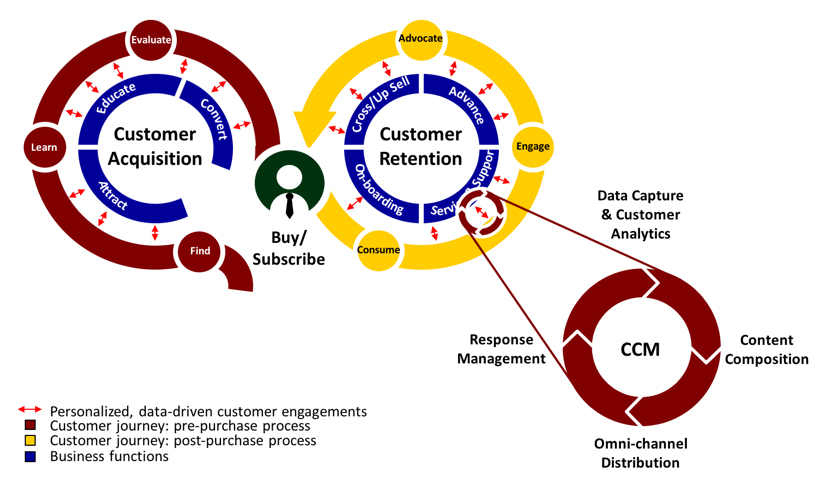
Image by: SIphotography, ©2016 Getty Images
In his famous management book first published in 1954, The Practice of Management, Peter F. Drucker stated, “The goal of a business is to create and keep customers.” Today, more than 60 years later, businesses are focusing on the customer again as they are pursuing a customer-centric business model, with customer experience as the new “holy grail.” Yet, there are significant differences between 1954 and today when it comes to creating and keeping customers. Today, there is a better understanding of the concept of customer experience in literature as well as in practice. Furthermore, businesses have a multitude of options at hand for managing the customer experience. Approaching it from a customer communications management (CCM) point of view will make it an easier process.
CCM facilitating the customer journey
In managing customer experience, the customer journey is an increasingly popular management tool. Similar to Drucker, who talks about creating and keeping customers, the customer journey, as defined by InfoTrends, describes a customer acquisition phase and a customer retention phase. Business functions are typically designed to support individual engagements between the business and the customer across the customer journey. CCM is a crucial element of customer journey management as it facilitates the communications in each of these engagements—whether that is an onboarding process, providing a bill or statement or servicing a customer call.

The customer acquisition phase should be supported by personalized, data-driven communications that are appropriate for where the customer is in the journey. Data capture and customer analytics provide the starting point for this process in each point of engagement, driving relevant and personalized content suitable for delivery via the customer’s preferred communication channels. The customer’s responses are captured, tracked and fed back into the business’s customer databases to inform subsequent cycles of communication and to support the next stage in the customer’s journey. Each engagement involves the rundown of a complete CCM cycle (data capture and customer analytics, content composition, omni-channel distribution and response management). Doing this in (nearly) real-time is important, because it allows the business and the customer to instantly switch between channels while continuing the conversation. This is the essence of an omni-channel approach.

Figure 1: InfoTrends’ Customer Journey Model
Source: "Customer Engagement Technologies State of the Market," InfoTrends 2015.
The customer acquisition phase should be supported by personalized, data-driven communications that are appropriate for where the customer is in the journey. Data capture and customer analytics provide the starting point for this process in each point of engagement, driving relevant and personalized content suitable for delivery via the customer’s preferred communication channels. The customer’s responses are captured, tracked and fed back into the business’s customer databases to inform subsequent cycles of communication and to support the next stage in the customer’s journey. Each engagement involves the rundown of a complete CCM cycle (data capture and customer analytics, content composition, omni-channel distribution and response management). Doing this in (nearly) real-time is important, because it allows the business and the customer to instantly switch between channels while continuing the conversation. This is the essence of an omni-channel approach.
Closing the loop is essential
One of the key challenges in managing customer communications across the customer journey is dealing with multiple departments, with increasing input from marketing and sales as well as customer support and service. Many of these internal divisions are mirrored and sometimes further entrenched by legacy information technology (IT) systems that cannot communicate with each other, resulting in siloed data and a fragmented view of the customer. For example, according to InfoTrends’ “Customer Engagement Technologies State of the Market 2015” research, nearly one in five enterprises cannot honor a customer’s channel preferences due to IT/data issues.
In addition to an often frustrating experience for customers who may have to deal with multiple and apparently unconnected departments over time, siloed data means missed opportunities for the business to identify developing customer needs or to detect/predict receptiveness to new offers. Ideally, there should be complete transparency within the business so that each person or group involved in any aspect of customer communications can see what the others have done—whether it is mailing regular transactional statements; running a multi-channel, personalized marketing campaign; or handling customer service calls in the call center.
To address these issues, businesses need to “close the loop” in their customer communications, allowing the feedback and insights gained from one engagement to be used by another across customer journeys. This directs and refines customer communications as well as allows for synchronization across multiple communication channels. The key underlying technology for closing the loop is data analytics.
In addition to an often frustrating experience for customers who may have to deal with multiple and apparently unconnected departments over time, siloed data means missed opportunities for the business to identify developing customer needs or to detect/predict receptiveness to new offers. Ideally, there should be complete transparency within the business so that each person or group involved in any aspect of customer communications can see what the others have done—whether it is mailing regular transactional statements; running a multi-channel, personalized marketing campaign; or handling customer service calls in the call center.
To address these issues, businesses need to “close the loop” in their customer communications, allowing the feedback and insights gained from one engagement to be used by another across customer journeys. This directs and refines customer communications as well as allows for synchronization across multiple communication channels. The key underlying technology for closing the loop is data analytics.
Data analytics make it possible
Synchronizing the communication experience across multiple engagements, providing customer-facing staff with real-time customer communication history, as well as offering better data-driven personalization and relevant communications are among the key initiatives enterprises are currently considering, according to InfoTrends’ research in key CCM industries. Data analytics applied within a CCM context is enabling this. In our research, enterprises expressed interest in increasing their IT spend in data analytics technology or have it on their short list of IT investments. Other enterprises indicated that they turn to service providers for help with data analytics and customer segmentation.
Having skills and expertise in data analytics is becoming, if it has not already, a competitive differentiator for businesses. The ability to master this discipline will be a deciding factor for whether or not businesses are successful in improving the customer experience by aligning their customer communications around the customer journey.
For more information, don’t miss DSF ’17, May 1-3, 2017 in Downtown Chicago. Visit http://documentstrategyforum.com or email jdunkel@EventEvolution.com for details.
Having skills and expertise in data analytics is becoming, if it has not already, a competitive differentiator for businesses. The ability to master this discipline will be a deciding factor for whether or not businesses are successful in improving the customer experience by aligning their customer communications around the customer journey.
For more information, don’t miss DSF ’17, May 1-3, 2017 in Downtown Chicago. Visit http://documentstrategyforum.com or email jdunkel@EventEvolution.com for details.
David Stabel is an associate director for InfoTrends’ customer engagement technologies advisory service. For more information on InfoTrends’ customer engagement technologies advisory service, visit www.infotrends.com. Follow him on Twitter @davidstabel.





















